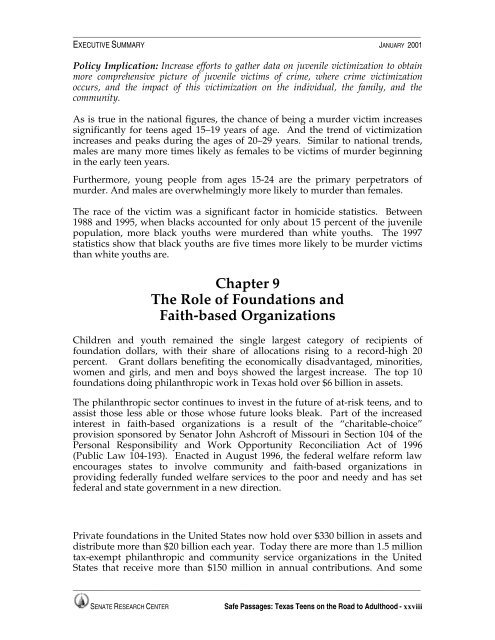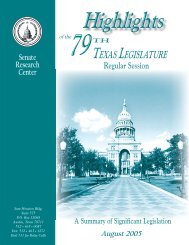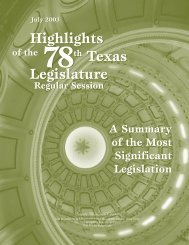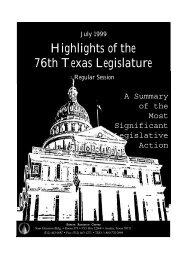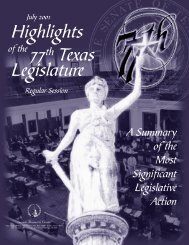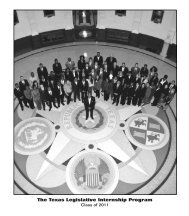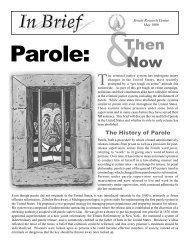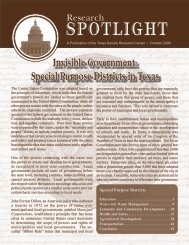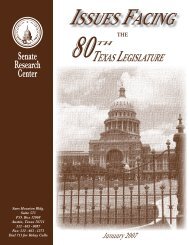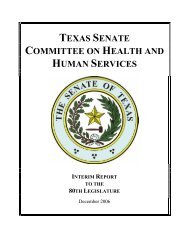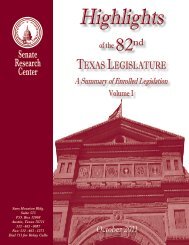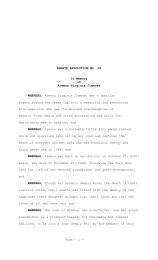Texas Teens Cover - Senate
Texas Teens Cover - Senate
Texas Teens Cover - Senate
You also want an ePaper? Increase the reach of your titles
YUMPU automatically turns print PDFs into web optimized ePapers that Google loves.
______________________________________________________________________________________<br />
EXECUTIVE SUMMARY JANUARY 2001<br />
Policy Implication: Increase efforts to gather data on juvenile victimization to obtain<br />
more comprehensive picture of juvenile victims of crime, where crime victimization<br />
occurs, and the impact of this victimization on the individual, the family, and the<br />
community.<br />
As is true in the national figures, the chance of being a murder victim increases<br />
significantly for teens aged 15–19 years of age. And the trend of victimization<br />
increases and peaks during the ages of 20–29 years. Similar to national trends,<br />
males are many more times likely as females to be victims of murder beginning<br />
in the early teen years.<br />
Furthermore, young people from ages 15-24 are the primary perpetrators of<br />
murder. And males are overwhelmingly more likely to murder than females.<br />
The race of the victim was a significant factor in homicide statistics. Between<br />
1988 and 1995, when blacks accounted for only about 15 percent of the juvenile<br />
population, more black youths were murdered than white youths. The 1997<br />
statistics show that black youths are five times more likely to be murder victims<br />
than white youths are.<br />
Chapter 9<br />
The Role of Foundations and<br />
Faith-based Organizations<br />
Children and youth remained the single largest category of recipients of<br />
foundation dollars, with their share of allocations rising to a record-high 20<br />
percent. Grant dollars benefiting the economically disadvantaged, minorities,<br />
women and girls, and men and boys showed the largest increase. The top 10<br />
foundations doing philanthropic work in <strong>Texas</strong> hold over $6 billion in assets.<br />
The philanthropic sector continues to invest in the future of at-risk teens, and to<br />
assist those less able or those whose future looks bleak. Part of the increased<br />
interest in faith-based organizations is a result of the “charitable-choice”<br />
provision sponsored by Senator John Ashcroft of Missouri in Section 104 of the<br />
Personal Responsibility and Work Opportunity Reconciliation Act of 1996<br />
(Public Law 104-193). Enacted in August 1996, the federal welfare reform law<br />
encourages states to involve community and faith-based organizations in<br />
providing federally funded welfare services to the poor and needy and has set<br />
federal and state government in a new direction.<br />
Private foundations in the United States now hold over $330 billion in assets and<br />
distribute more than $20 billion each year. Today there are more than 1.5 million<br />
tax-exempt philanthropic and community service organizations in the United<br />
States that receive more than $150 million in annual contributions. And some<br />
______________________________________________________________________________________<br />
SENATE RESEARCH CENTER<br />
Safe Passages: <strong>Texas</strong> <strong>Teens</strong> on the Road to Adulthood - xxviii


